1.5E: Exercises for Section 1.6
- Last updated
- May 26, 2022
- Save as PDF
- Page ID
- 102688

- Zoya Kravets
- Mission College
( \newcommand{\kernel}{\mathrm{null}\,}\)
In exercises 1 - 4, evaluate the given exponential functions as indicated, accurate to two significant digits after the decimal.
1) f(x)=5x
a. x=3
b. x=12
c. x=√2
- Answer
- a. 125
b. 2.24
c. 9.74
2) f(x)=(0.3)x
a. x=−1
b. x=4
c. x=−1.5
3) f(x)=10x
a. x=−2
b. x=4
c. x=53
- Answer
- a. 0.01
b. 10,000
c. 46.42
4) f(x)=ex
a. x=2
b. x=−3.2
c. x=π
In exercises 5 - 10, match the exponential equation to the correct graph.
a. y=4−x
b. y=3x−1
c. y=2x+1
d. y=(12)x+2
e. y=−3−x
f. y=1−5x
5)
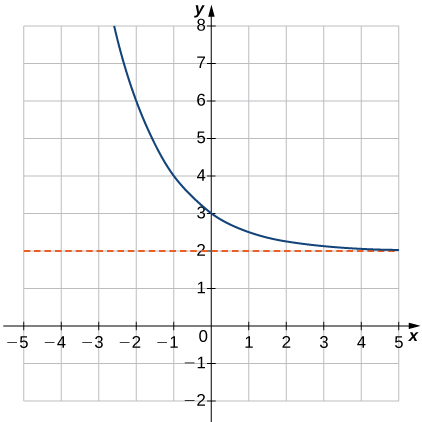
- Answer
- d
6)
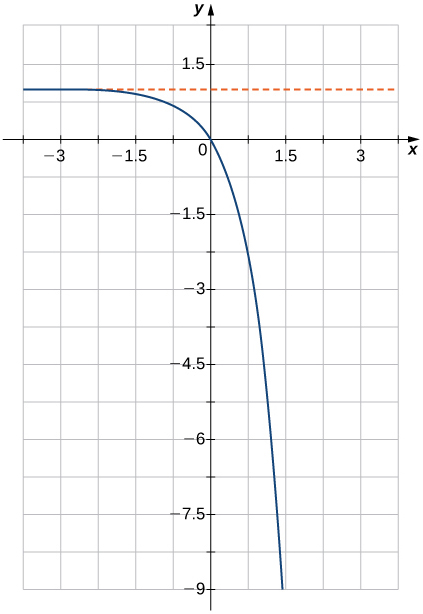
7)
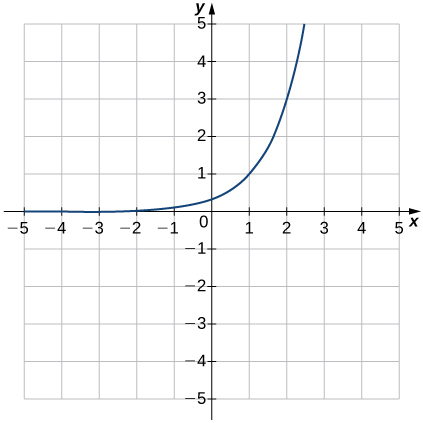
- Answer
- b
8)
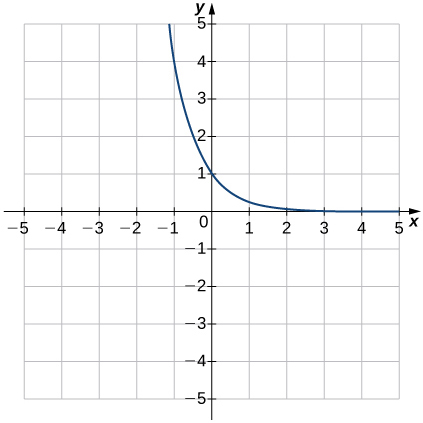
9)
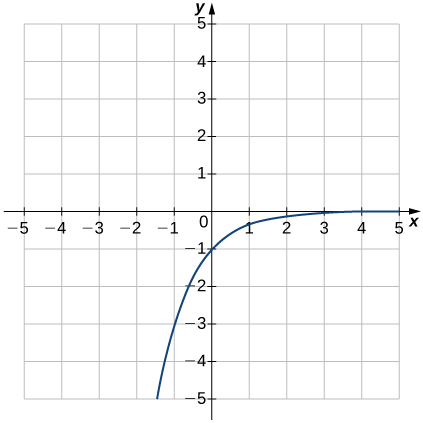
- Answer
- e
10)

In exercises 11 - 17, sketch the graph of the exponential function. Determine the domain, range, and horizontal asymptote.
11) f(x)=ex+2
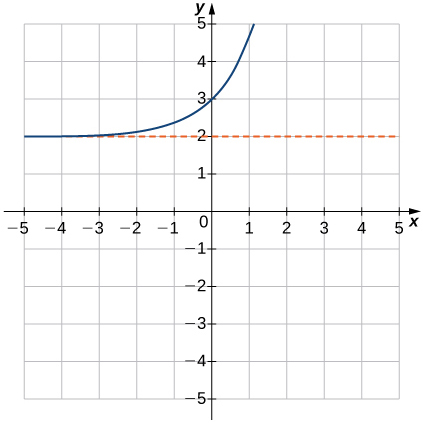
- Answer
- Domain: all real numbers, Range: (2,∞),y=2
12) f(x)=−2x
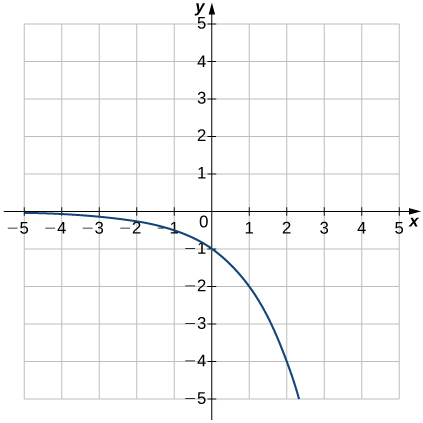
13) f(x)=3x+1

- Answer
- Domain: all real numbers, Range: (0,∞),y=0
14) f(x)=4x−1
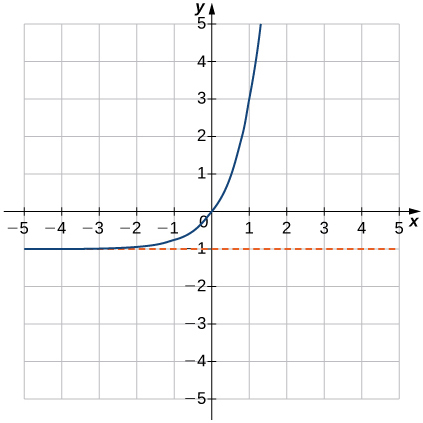
15) f(x)=1−2−x
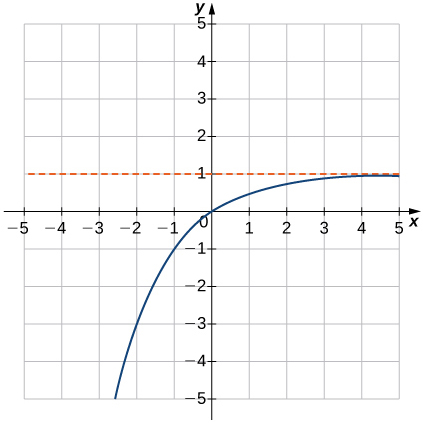
- Answer
- Domain: all real numbers, Range: (−∞,1),y=1
16) f(x)=5x+1+2
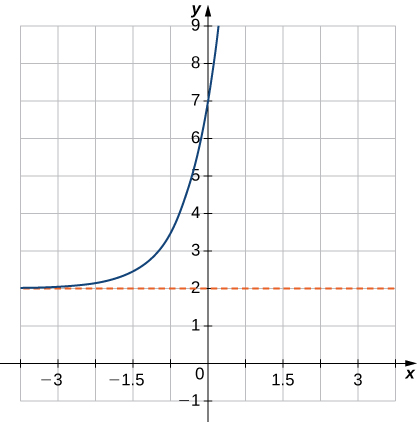
17) f(x)=e−x−1
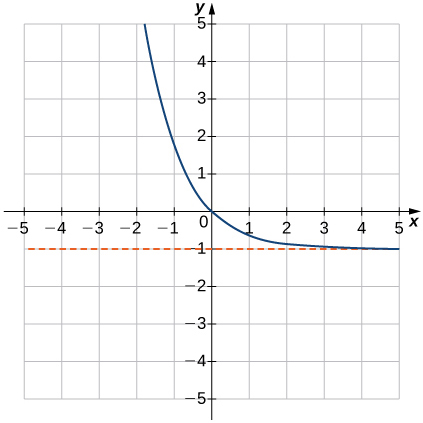
- Answer
- Domain: all real numbers, Range: (−1,∞),y=−1
In exercises 18 - 25, write the equation in equivalent exponential form.
18) log381=4
19) log82=13
- Answer
- 81/3=2
20) log51=0
21) log525=2
- Answer
- 52=25
22) log0.1=−1
23) ln(1e3)=−3
- Answer
- e−3=1e3
24) log93=0.5
25) ln1=0
- Answer
- e0=1
In exercises 26 - 35, write the equation in equivalent logarithmic form.
26) 23=8
27) 4−2=116
- Answer
- log4(116)=−2
28) 102=100
29) 90=1
- Answer
- log91=0
30) (13)3=127
31) 3√64=4
- Answer
- log644=13
32) ex=y
33) 9y=150
- Answer
- log9150=y
34) b3=45
35) 4−3/2=0.125
- Answer
- log40.125=−32
In exercises 36 - 41, sketch the graph of the logarithmic function. Determine the domain, range, and vertical asymptote.
36) f(x)=3+lnx
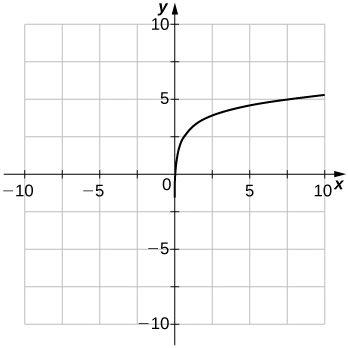
37) f(x)=ln(x−1)
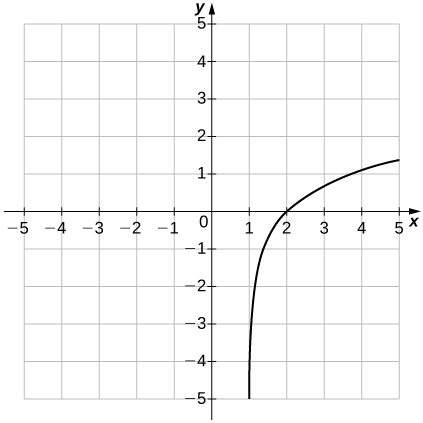
- Answer
- Domain: (1,∞), Range: (−∞,∞),x=1
38) f(x)=ln(−x)
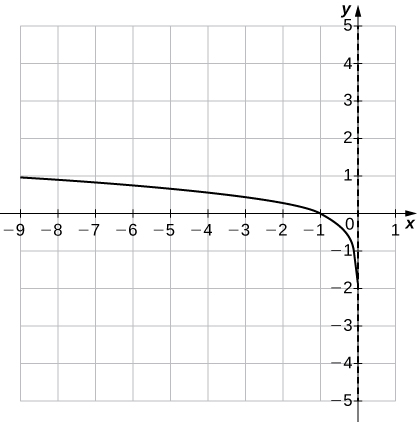
39) f(x)=1−lnx
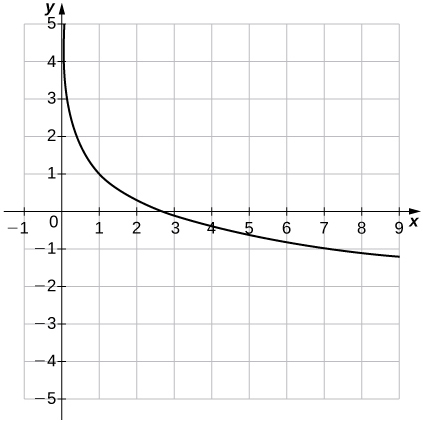
- Answer
- Domain: (0,∞), Range: (−∞,∞),x=0
40) f(x)=logx−1
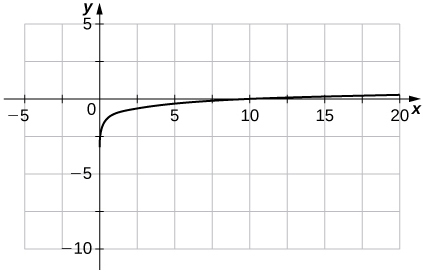
41) f(x)=ln(x+1)
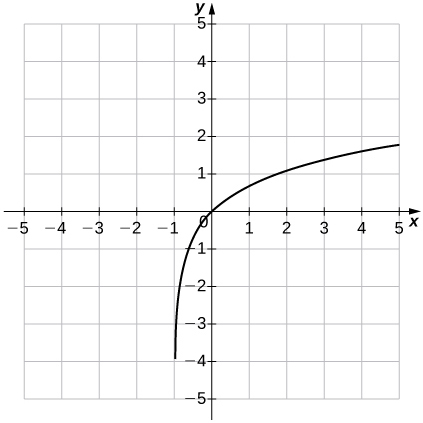
- Answer
- Domain: (−1,∞), Range: (−∞,∞), x=−1
In exercises 42 - 47, use properties of logarithms to write the expressions as a sum, difference, and/or product of logarithms.
42) logx4y
43) log39a3b
- Answer
- 2+3log3a−log3b
44) lna3√b
45) log5√125xy3
- Answer
- 32+12log5x+32log5y
46) log43√xy64
47) ln(6√e3)
- Answer
- −32+ln6
In exercises 48 - 55, solve the exponential equation exactly.
48) 5x=125
49) e3x−15=0
- Answer
- ln153
50) 8x=4
51) 4x+1−32=0
- Answer
- 32
52) 3x/14=110
53) 10x=7.21
- Answer
- log7.21
54) 4⋅23x−20=0
55) 73x−2=11
- Answer
- 23+log113log7
In exercises 56 - 63, solve the logarithmic equation exactly, if possible.
56) log3x=0
57) log5x=−2
- Answer
- x=125
58) log4(x+5)=0
59) log(2x−7)=0
- Answer
- x=4
60) ln√x+3=2
61) log6(x+9)+log6x=2
- Answer
- x=3
62) log4(x+2)−log4(x−1)=0
63) lnx+ln(x−2)=ln4
- Answer
- 1+√5
In exercises 64 - 69, use the change-of-base formula and either base 10 or base e to evaluate the given expressions. Answer in exact form and in approximate form, rounding to four decimal places.
64) log547
65) log782
- Answer
- log82log7≈2.2646
66) log6103
67) log0.5211
- Answer
- log211log0.5≈−7.7211
68) log2π
69) log0.20.452
- Answer
- log0.452log0.2≈0.4934
70) Rewrite the following expressions in terms of exponentials and simplify.
a. 2cosh(lnx) b. cosh4x+sinh4x c. cosh2x−sinh2x d. ln(coshx+sinhx)+ln(coshx−sinhx)
71) [T] The number of bacteria N in a culture after t days can be modeled by the function N(t)=1300⋅(2)t/4. Find the number of bacteria present after 15 days.
- Answer
- ∼17,491
72) [T] The demand D (in millions of barrels) for oil in an oil-rich country is given by the function D(p)=150⋅(2.7)−0.25p, where p is the price (in dollars) of a barrel of oil. Find the amount of oil demanded (to the nearest million barrels) when the price is between $15 and $20.
73) [T] The amount A of a $100,000 investment paying continuously and compounded for t years is given by A(t)=100,000⋅e0.055t. Find the amount A accumulated in 5 years.
- Answer
- Approximately $131,653 is accumulated in 5 years.
74) [T] An investment is compounded monthly, quarterly, or yearly and is given by the function A=P(1+jn)nt, where A is the value of the investment at time t, P is the initial principle that was invested, j is the annual interest rate, and n is the number of time the interest is compounded per year. Given a yearly interest rate of 3.5% and an initial principle of $100,000, find the amount A accumulated in 5 years for interest that is compounded a. daily, b., monthly, c. quarterly, and d. yearly.
75) [T] The concentration of hydrogen ions in a substance is denoted by [H+], measured in moles per liter. The pH of a substance is defined by the logarithmic function pH=−log[H+]. This function is used to measure the acidity of a substance. The pH of water is 7. A substance with a pH less than 7 is an acid, whereas one that has a pH of more than 7 is a base.
a. Find the pH of the following substances. Round answers to one digit.
b. Determine whether the substance is an acid or a base.
i. Eggs: [H+]=1.6×10−8 mol/L
ii. Beer: [H+]=3.16×10−3 mol/L
iii. Tomato Juice: [H+]=7.94×10−5 mol/L
- Answer
- i. a. pH = 8 b. Base
ii. a. pH = 3 b. Acid
iii. a. pH = 4 b. Acid
76) [T] Iodine-131 is a radioactive substance that decays according to the function Q(t)=Q0⋅e−0.08664t, where Q0 is the initial quantity of a sample of the substance and t is in days. Determine how long it takes (to the nearest day) for 95% of a quantity to decay.
77) [T] According to the World Bank, at the end of 2013 (t=0) the U.S. population was 316 million and was increasing according to the following model:
P(t)=316e0.0074t,
where P is measured in millions of people and t is measured in years after 2013.
a. Based on this model, what will be the population of the United States in 2020?
b. Determine when the U.S. population will be twice what it is in 2013.
- Answer
- a. ∼333 million
b. 94 years from 2013, or in 2107
78) [T] The amount A accumulated after 1000 dollars is invested for t years at an interest rate of 4% is modeled by the function A(t)=1000(1.04)t.
a. Find the amount accumulated after 5 years and 10 years.
b. Determine how long it takes for the original investment to triple.
79) [T] A bacterial colony grown in a lab is known to double in number in 12 hours. Suppose, initially, there are 1000 bacteria present.
a. Use the exponential function Q=Q0ekt to determine the value k, which is the growth rate of the bacteria. Round to four decimal places.
b. Determine approximately how long it takes for 200,000 bacteria to grow.
- Answer
- a. k≈0.0578
b. ≈92 hours
80) [T] The rabbit population on a game reserve doubles every 6 months. Suppose there were 120 rabbits initially.
a. Use the exponential function P=P0at to determine the growth rate constant a. Round to four decimal places.
b. Use the function in part a. to determine approximately how long it takes for the rabbit population to reach 3500.
81) [T] The 1906 earthquake in San Francisco had a magnitude of 8.3 on the Richter scale. At the same time, in Japan, an earthquake with magnitude 4.9 caused only minor damage. Approximately how much more energy was released by the San Francisco earthquake than by the Japanese earthquake?
- Answer
- The San Francisco earthquake had 103.4 or ∼2512 times more energy than the Japan earthquake.
Contributors
Gilbert Strang (MIT) and Edwin “Jed” Herman (Harvey Mudd) with many contributing authors. This content by OpenStax is licensed with a CC-BY-SA-NC 4.0 license. Download for free at http://cnx.org.

